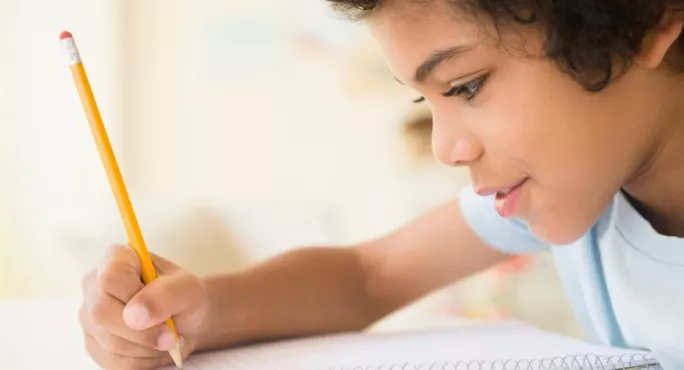
- Home
- How to improve your pupils’ handwriting
How to improve your pupils’ handwriting

As a class teacher, I was always surprised by how many pupils had a range of different handwriting styles, which they effortlessly switched between depending upon the needs of the audience.
For example, if we were involved in a handwriting lesson, children in my class would generally produce beautifully formed letters, joined appropriately, to result in an artistic, finished piece of writing that would have not looked out of place in a medieval scriptorium.
Later in the day, we would be involved in a literacy lesson where the focus was more concentrated on a grammatical technique or a descriptive device and, while not quite as technically formed as in the handwriting session, children’s writing would still be of a legible script and generally look neat and well formed.
Downward spiral
But in the afternoon, sessions of history, geography and other foundation subjects would tell a different tale. Remarkably for eight- and nine-year-olds, the children had somehow reached the conclusion that in these subjects content was more important than presentation and, like a crazed scientist - or perhaps the local GP - their written script now resembled the manic scrawl of an abstract artist with letter size and formation making way for a free-flowing and expressive scrawl. On many occasions, it had me referring back to their previous work, wondering if this was indeed the same child.
Upon moving to headship, I was, of course, less accepting of other teacher’s appreciation of their children’s ability to switch formality in handwriting styles and I tried for many years to instil a mantra that every piece of writing should be the best piece of writing, and that presentation is as important as content.
Yet, to my frustration and dismay, still the wide variation and sliding scale of handwriting mastery remained, depending, it seemed, upon the time of day and nature of the lesson.
Handwriting fears
And then came the introduction of 1:1 devices, or Chromebooks in our case. As an advocate of technology and computing (my own background being in ICT), I was keen to sell this idea to my governing body as I firmly believe that the advantages of such an approach would have a dramatic and positive impact on the education of our children. The obvious and most cited barrier to this, however, was “what about handwriting?” (well, there was spelling, too, but that’s another story).
It was an obvious but very important question that needed to be addressed.
So we looked at what it was that made children’s handwriting and presentation good in some subjects and not others. Was it the explicit teaching of letter formation and joins? Was it the battle between cursive and printed script? Was it some unconscious message around content over presentation, or perhaps an unwritten understanding around the hierarchy of importance within subjects of the curriculum?
Our musings led us to one, simple conclusion: expectation.
And so was born our approach to handwriting: The Line of Expectation.
Handwriting as part of every lesson
It is a rather grand and dramatic title for something that, in hindsight, is a simple underpinning philosophy for improving children’s presentation.
We know that in handwriting lessons children produce beautiful handwriting, so why not make handwriting a part of every lesson?
By asking children to produce just one line of handwriting at the beginning of every lesson, we set out the expectation for the rest of that piece of work. Yes, this line is modelled by the teacher. Yes, this line is used to teach a join or a particular formation. And yes, this line is copied beautifully into children’s books as in a traditional handwriting lesson.
But more importantly, this line sets the expectation for the rest of that piece of work.
Free and easy
This is not a handwriting scheme or script. This is a philosophy on setting out to do our best and then expecting this in the rest of a piece of work. It sets an expectation - if you can do it this well in this line, you can do it this well for the rest of this piece of work. It is what we expect of your handwriting.
More importantly, perhaps, it is what we expect our teaching staff to expect of their children.
Almost five years on from the introduction of 1:1 Chromebooks, which are used in approximately 50 per cent of children’s work, the presentation of their handwritten work now gives me, the teachers and the children, pride. Of course, we have ensured that there has been input and training, consistency and guidance in the teaching of handwriting. More importantly, however, we have set an expectation on presentation. An expectation which has not come from spending hours on discreet handwriting lessons or from investing in handwriting books which have more lines on them than a musical stave.
It has come, indirectly, from the introduction of keyboards and more significantly, from ensuring that when pen meets paper, if you can do it on one line, you can do it on them all.
Harvey McCarthy is headteacher at Filey Junior School, North Yorkshire
Tes has produced free guides to teaching handwriting that can be found here:
Essential components of a handwriting lesson
The tools you need to ensure outstanding handwriting
How to physically prepare children for handwriting
Register with Tes and you can read five free articles every month, plus you'll have access to our range of award-winning newsletters.
Keep reading for just £4.90 per month
You've reached your limit of free articles this month. Subscribe for £4.90 per month for three months and get:
- Unlimited access to all Tes magazine content
- Exclusive subscriber-only stories
- Award-winning email newsletters
You've reached your limit of free articles this month. Subscribe for £4.90 per month for three months and get:
- Unlimited access to all Tes magazine content
- Exclusive subscriber-only stories
- Award-winning email newsletters